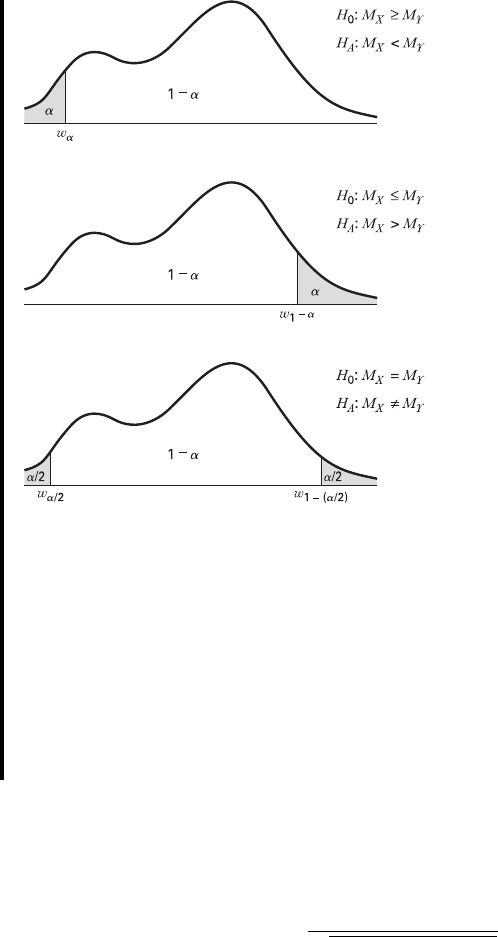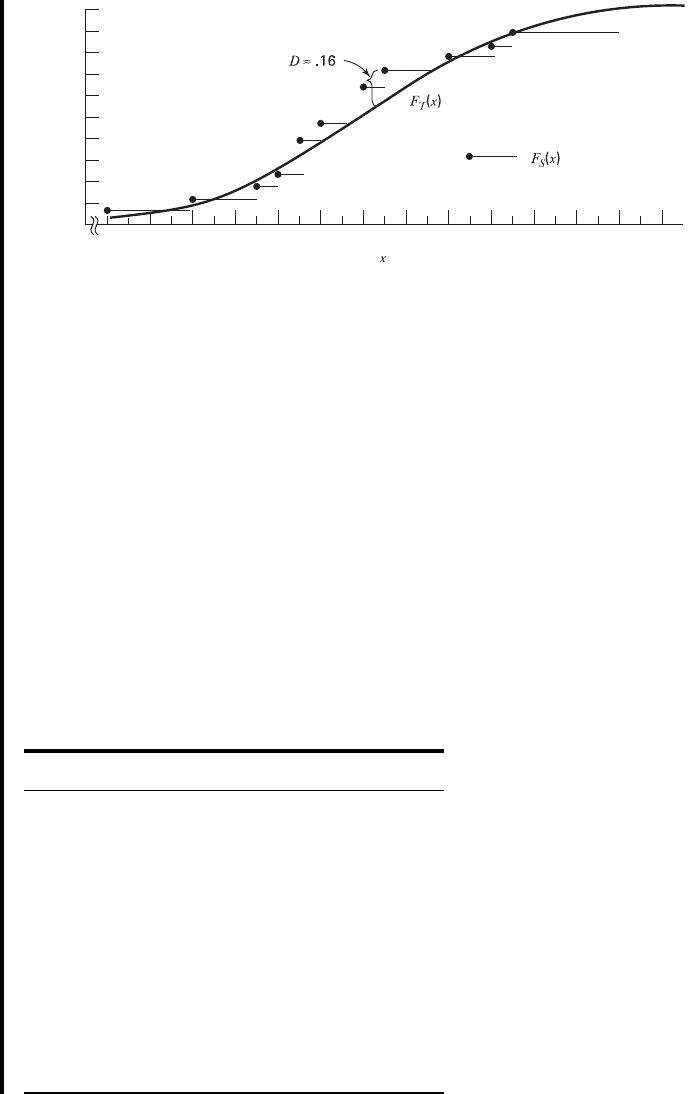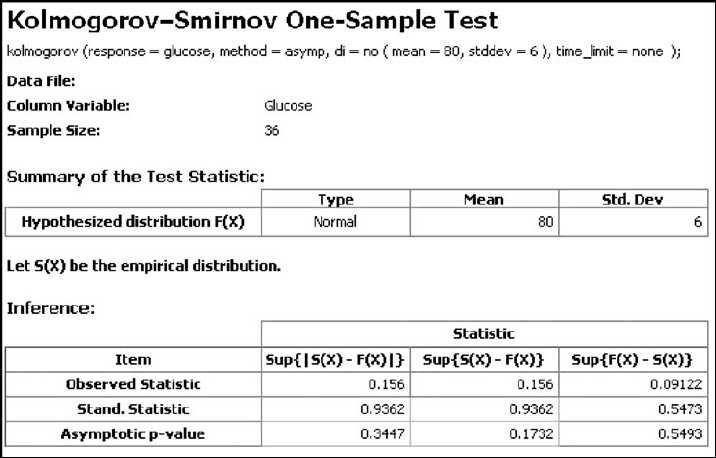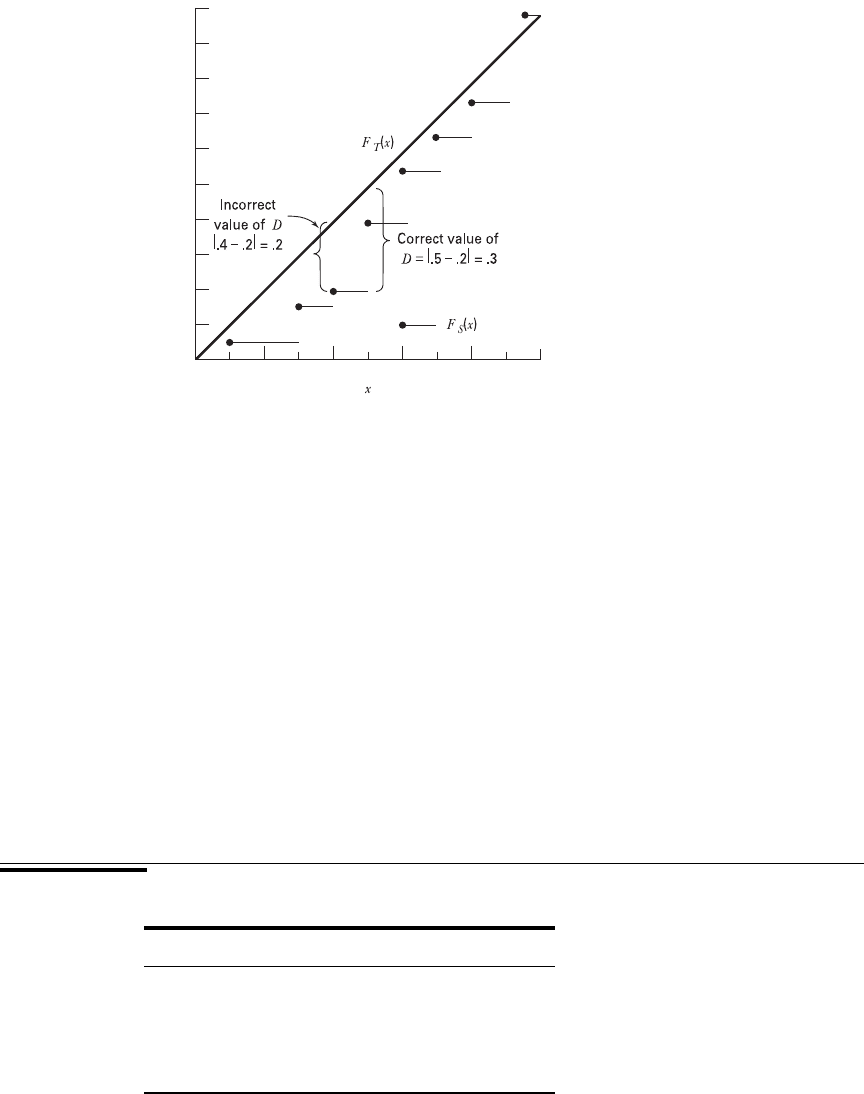Daniel W.W. Biostatistics: A Foundation for Analysis in the Health Sciences
Подождите немного. Документ загружается.


8. Statistical decision. When we enter Table L with and
we find the critical value of to be 45. Since we
reject
9. Conclusion. We conclude that is smaller than This leads to the
conclusion that prolonged inhalation of cadmium oxide does reduce the
hemoglobin level.
10. p value. Since we have for this test
■
Large-Sample Approximation When either n or m is greater than 20 we
cannot use Appendix Table L to obtain critical values for the Mann–Whitney test. When
this is the case we may compute
(13.6.2)
and compare the result, for significance, with critical values of the standard normal
distribution.
Mann–Whitney Statistic and the Wilcoxon Statistic As was noted
at the beginning of this section, the Mann–Whitney test is sometimes referred to as the
z =
T - mn>2
1nm1n + m + 12>12
.005 7 p 7 .001.22 6 25 6 30,
M
Y
.M
X
H
0
.
25 6 45,w
a
a = .05,
n = 15, m = 10,
13.6 THE MANN–WHITNEY TEST 707
FIGURE 13.6.1 Mann–Whitney test rejection regions for three sets of hypotheses.

Ranks
y N Mean Rank Sum of Rank
x 1.000000 15 9.67 146.00
2.000000 10 18.00 180.00
Total 25
Test Statistic
b
x
Mann-Whitney U 25.000
Wilcoxon W 145.000
Z 2.775
Asymp. Sig. (2-tailed) .006
Exact Sig. [2*(1-tailed Sig.)] .004
a
a. Not corrected for ties
b. Grouping Variable: y
708 CHAPTER 13 NONPARAMETRIC AND DISTRIBUTION-FREE STATISTICS
Dialog box: Session command:
Stat ➤ Nonparametrics ➤ Mann–Whitney MTB > Mann-Whitney 95.0
C1 C2;
SUBC > Alternative 1.
Type C1 in First Sample and C2 in Second Sample.
At Alternative choose less than.
Click OK .
Output:
Mann–Whitney Test and CI: C1, C2
C1 N 15 Median 15.300
C2 N 10 Median 16.550
Point estimate for ETA1 ETA2 is 1.300
95.1 Percent C.I. for ETA1 ETA2 is (2.300,0.600)
W 145.0
Test of ETA1 ETA2 vs. ETA1 ETA2 is significant at 0.0030
The test is significant at 0.0030 (adjusted for ties)
FIGURE 13.6.2 MINITAB procedure and output for Example 13.6.1.
FIGURE 13.6.3 SPSS output for Example 13.6.1.

Mann–Whitney-Wilcoxon test. Indeed, many computer packages give the test value of
both the Mann–Whitney test (U) and the Wilcoxon test (W). These two tests are alge-
braically equivalent tests, and are related by the following equality when there are no
ties in the data:
(13.6.3)
Computer Analysis Many statistics software packages will perform the
Mann–Whitney test. With the data of two samples stored in Columns 1 and 2, for
example, MINITAB will perform a one-sided or two-sided test. The MINITAB proce-
dure and output for Example 13.6.1 are shown in Figure 13.6.2.
The SPSS output for Example 13.6.1 is shown in Figure 13.6.3. As we see this out-
put provides the Mann–Whitney test, the Wilcoxon test, and large-sample z approximation.
EXERCISES
13.6.1 Cranor and Christensen (A-4) studied diabetics insured by two employers. Group 1 subjects
were employed by the City of Asheville, North Carolina, and group 2 subjects were employed
by Mission–St. Joseph’s Health System. At the start of the study, the researchers performed the
Mann–Whitney test to determine if a significant difference in weight existed between the two
study groups. The data are displayed in the following table.
Weight (Pounds)
Group 1 Group 2
252 215 240 185 195 220
240 190 302 310 210 295
205 270 312 212 190 202
200 159 126 238 172 268
170 204 268 184 190 220
170 215 215 136 140 311
320 254 183 200 280 164
148 164 287 270 264 206
214 288 210 200 270 170
270 138 225 212 210 190
265 240 258 182 192
203 217 221 225 126
Source: Carole W. Carnor, Ph.D. Used with permission.
May we conclude, on the basis of these data, that patients in the two groups differ significantly
with respect to weight? Let
13.6.2 One of the purposes of a study by Liu et al. (A-5) was to determine the effects of MRZ 2/579 (a
receptor antagonist shown to provide neuroprotective activity in vivo and in vitro) on neurological
a = .05.
U + W =
m1m + 2n + 12
2
EXERCISES 709

deficit in Sprague–Dawley rats. In the study, 10 rats were to receive MRZ 2/579 and nine rats were
to receive regular saline. Prior to treatment, researchers studied the blood gas levels in the two groups
of rats. The following table shows the levels for the two groups.
Saline (mmHg) MRZ 2/579 (mmHg)
112.5 133.3
106.3 106.4
99.5 113.1
98.3 117.2
103.4 126.4
109.4 98.1
108.9 113.4
107.4 116.8
116.5
Source: Ludmila Belayev, M.D. Used with permission.
May we conclude, on the basis of these data, that, in general, subjects on saline have, on average,
lower levels at baseline? Let
13.6.3 The purpose of a study by researchers at the Cleveland (Ohio) Clinic (A-6) was to determine if
the use of Flomax
®
reduced the urinary side effects commonly experienced by patients following
brachytherapy (permanent radioactive seed implant) treatment for prostate cancer. The following
table shows the American Urological Association (AUA) symptom index scores for two groups of
subjects after 8 weeks of treatment. The higher the AUA index, the more severe the urinary obstruc-
tion and irritation.
AUA Index (Flomax
®
) AUA Index (Placebo)
1511 1612
1511 1612
2611 2613
2611 2614
2712 2617
2712 3718
3713 3819
3714 3820
3816 3923
4816 4923
4818 410
4821 410
4931 511
49 511
410 512
Source: Chandana Reddy, M.S. Used with permission.
May we conclude, on the basis of these data, that the median AUA index in the Flomax
®
group
differs significantly from the median AUA index of the placebo group? Let a = .05.
a = .01.pO
2
pO
2
710 CHAPTER 13 NONPARAMETRIC AND DISTRIBUTION-FREE STATISTICS

13.7 THE KOLMOGOROV–SMIRNOV
GOODNESS-OF-FIT TEST
When one wishes to know how well the distribution of sample data conforms to some
theoretical distribution, a test known as the Kolmogorov–Smirnov goodness-of-fit test
provides an alternative to the chi-square goodness-of-fit test discussed in Chapter 12. The
test gets its name from A. Kolmogorov and N. V. Smirnov, two Russian mathematicians
who introduced two closely related tests in the 1930s.
Kolmogorov’s work (6) is concerned with the one-sample case as discussed here.
Smirnov’s work (7) deals with the case involving two samples in which interest centers
on testing the hypothesis that the distributions of the two-parent populations are iden-
tical. The test for the first situation is frequently referred to as the Kolmogorov–Smirnov
one-sample test. The test for the two-sample case, commonly referred to as the
Kolmogorov–Smirnov two-sample test, will not be discussed here.
The Test Statistic In using the Kolmogorov–Smirnov goodness-of-fit test, a
comparison is made between some theoretical cumulative distribution function,
and a sample cumulative distribution function, The sample is a random sample
from a population with unknown cumulative distribution function It will be recalled
(Section 4.2) that a cumulative distribution function gives the probability that X is equal
to or less than a particular value, x. That is, by means of the sample cumulative distri-
bution function, we may estimate If there is close agreement between
the theoretical and sample cumulative distributions, the hypothesis that the sample was
drawn from the population with the specified cumulative distribution function, is
supported. If, however, there is a discrepancy between the theoretical and observed cumu-
lative distribution functions too great to be attributed to chance alone, when is true,
the hypothesis is rejected.
The difference between the theoretical cumulative distribution function, and
the sample cumulative distribution function, is measured by the statistic D, which
is the greatest vertical distance between and When a two-sided test is appro-
priate, that is, when the hypotheses are
for all x from
for at least one x
the test statistic is
(13.7.1)
which is read, “D equals the supremum (greatest), over all x, of the absolute value of the
difference minus ”
The null hypothesis is rejected at the level of significance if the computed
value of D exceeds the value shown in Appendix Table M for (two-sided) and
the sample size n.
1 - a
a
F
T
1X 2.F
S
1X 2
D = sup
x
ƒ
F
S
1x2- F
T
1x2
ƒ
H
A
: F1x2Z F
T
1x2
-
q
to +
q
H
0
: F1x2= F
T
1x2
F
T
1x2.F
S
1x2
F
S
1x2,
F
T
1x2,
H
0
F
T
1x2,
P1X … x2.F
S
1x2,
F1x2.
F
S
1x2.
F
T
1x2,
13.7 THE KOLMOGOROV–SMIRNOV GOODNESS-OF-FIT TEST 711

Assumptions The assumptions underlying the Kolmogorov–Smirnov test include
the following:
1. The sample is a random sample.
2. The hypothesized distribution is continuous.
When values of D are based on a discrete theoretical distribution, the test is con-
servative. When the test is used with discrete data, then, the investigator should bear in
mind that the true probability of committing a type I error is at most equal to the
stated level of significance. The test is also conservative if one or more parameters have
to be estimated from sample data.
EXAMPLE 13.7.1
Fasting blood glucose determinations made on 36 nonobese, apparently healthy, adult males
are shown in Table 13.7.1. We wish to know if we may conclude that these data are not
from a normally distributed population with a mean of 80 and a standard deviation of 6.
Solution:
1. Data. See Table 13.7.1.
2. Assumptions. The sample available is a simple random sample from a
continuous population distribution.
3. Hypotheses. The appropriate hypotheses are
for all x from to
for at least one x
Let
4. Test statistic. See Equation 13.7.1.
5. Distribution of test statistic. Critical values of the test statistic for
selected values of are given in Appendix Table M.
6. Decision rule. Reject if the computed value of D exceeds .221, the
critical value of D for and
7. Calculation of test statistic. Our first step is to compute values of
as shown in Table 13.7.2.F
S
1x2
a = .05.n = 36
H
0
a
a = .05.
H
A
: F1x2Z F
T
1x2
+
q
-
q
H
0
: F1x2= F
T
1x2
a,
F
T
1x2
712
CHAPTER 13 NONPARAMETRIC AND DISTRIBUTION-FREE STATISTICS
TABLE 13.7.1 Fasting Blood Glucose Values
(mg/100 ml) for 36 Nonobese, Apparently
Healthy, Adult Males
75 92 80 80 84 72
84 77 81 77 75 81
80 92 72 77 78 76
77 86 77 92 80 78
68 78 92 68 80 81
87 76 80 87 77 86

Each value of is obtained by dividing the corresponding
cumulative frequency by the sample size. For example, the first value of
We obtain values of by first converting each observed value
of x to a value of the standard normal variable, z. From Appendix Table
D we then find the area between and z. From these areas we are
able to compute values of The procedure, which is similar to that
used to obtain expected relative frequencies in the chi-square goodness-
of-fit test, is summarized in Table 13.7.3.
F
T
1x2.
-
q
F
T
1x2
F
S
1x2= 2>36 = .0556.
F
S
1x2
13.7 THE KOLMOGOROV–SMIRNOV GOODNESS-OF-FIT TEST 713
TABLE 13.7.2 Values of for Example 13.7.1
Cumulative
x
Frequency Frequency
68 2 2 .0556
72 2 4 .1111
75 2 6 .1667
76 2 8 .2222
77 6 14 .3889
78 3 17 .4722
80 6 23 .6389
81 3 26 .7222
84 2 28 .7778
86 2 30 .8333
87 2 32 .8889
92 4 36 1.0000
36
F
S
(x )
F
S
(x )
TABLE 13.7.3 Steps in Calculation
of for Example 13.7.1
x
/6
68 .0228
72 .0918
75 .2033
76 .2514
77 .3085
78 .3707
80 .00 .5000
81 .17 .5675
84 .67 .7486
86 1.00 .8413
87 1.17 .8790
92 2.00 .9772
-.33
-.50
-.67
-.83
-1.33
-2.00
F
T
(x)z (x 80)
F
T
(x)

The test statistic D may be computed algebraically, or it may be
determined graphically by actually measuring the largest vertical distance
between the curves of and on a graph. The graphs of the
two distributions are shown in Figure 13.7.1.
Examination of the graphs of and reveals that
Now let us compute the value of D alge-
braically. The possible values of are shown in Table
13.7.4. This table shows that the exact value of D is .1547.
8. Statistical decision. Reference to Table M reveals that a computed D
of .1547 is not significant at any reasonable level. Therefore, we are not
willing to reject .
9. Conclusion. The sample may have come from the specified distribution.
10. p value. Since we have a two-sided test, and since . we
have .p 7 .20
1547 6 .174,
H
0
ƒ
F
S
1x2- F
T
1x2
ƒ
D L .16 = 1.72 - .562.
F
T
1x2F
S
1x2
F
T
1x2F
S
1x2
714
CHAPTER 13 NONPARAMETRIC AND DISTRIBUTION-FREE STATISTICS
68 70 72 74 76 78 80 82 84 86 88 90 92 94
Cumulative relative frequency
1.00
.90
.80
.70
.60
.50
.40
.30
.20
.10
FIGURE 13.7.1 and for Example 13.7.1.F
T
1x2F
S
1x2
TABLE 13.7.4 Calculation of for
Example 13.7.1
x
68 .0556 .0228 .0328
72 .1111 .0918 .0193
75 .1667 .2033 .0366
76 .2222 .2514 .0292
77 .3889 .3085 .0804
78 .4722 .3707 .1015
80 .6389 .5000 .1389
81 .7222 .5675 .1547
84 .7778 .7486 .0292
86 .8333 .8413 .0080
87 .8889 .8790 .0099
92 1.0000 .9772 .0228
ƒ
F
S
(x) F
T
(x)
ƒ
F
T
(x)F
S
(x)
円F
S
(x) F
T
(x)円
■

StatXact is often used for nonparametric statistical analysis. This particular soft-
ware program has a nonparametric module that contains nearly all of the commonly
used nonparametric tests, and many less common, but useful, procedures as well. Com-
puter analysis using StatXact for the data in Example 13.7.1 is shown in Figure 13.7.2.
Note that it provides the test statistic of D 0.156 and the exact two-sided p value
of .3447.
A Precaution The reader should be aware that in determining the value of D, it
is not always sufficient to compute and choose from the possible values of
The largest vertical distance between and may not occur
at an observed value, x, but at some other value of X. Such a situation is illustrated in
Figure 13.7.3. We see that if only values of at the left endpoints of
the horizontal bars are considered, we would incorrectly compute D as
One can see by examining the graph, however, that the largest vertical distance between
and occurs at the right endpoint of the horizontal bar originating at the
point corresponding to and the correct value of D is
One can determine the correct value of D algebraically by computing, in addition
to the differences the differences for all values of
where the number of different values of x and
The correct value of the test statistic will then be
(13.7.2)D = maximum
1 … i … r
5maximum3
ƒ
F
S
1x
i
2- F
T
1x
i
2
ƒ
,
ƒ
F
S
1x
i -1
2- F
T
1x
i
2
ƒ
46
F
S
1x
0
2= 0.r =i = 1, 2,...,r + 1,
ƒ
F
S
1x
i -1
2- F
T
1x
i
2
ƒƒ
F
S
1x2- F
T
1x2
ƒ
,
ƒ
.5 - .2
ƒ
= .3.x = .4,
F
T
1x2F
S
1x2
ƒ
.2 - .4
ƒ
= .2.
ƒ
F
S
1x2- F
T
1x2
ƒ
F
T
1x2F
S
1x2
ƒ
F
S
1x2- F
T
1x2
ƒ
.
13.7 THE KOLMOGOROV–SMIRNOV GOODNESS-OF-FIT TEST 715
FIGURE 13.7.2 StatXact output for Example 13.7.1

Advantages and Disadvantages The following are some important
points of comparison between the Kolmogorov–Smirnov and the chi-square goodness-
of-fit tests.
1. The Kolmogorov–Smirnov test does not require that the observations be grouped as
is the case with the chi-square test. The consequence of this difference is that the
Kolmogorov–Smirnov test makes use of all the information present in a set of data.
2. The Kolmogorov–Smirnov test can be used with any size sample. It will be recalled
that certain minimum sample sizes are required for the use of the chi-square test.
3. As has been noted, the Kolmogorov–Smirnov test is not applicable when parame-
ters have to be estimated from the sample. The chi-square test may be used in these
situations by reducing the degrees of freedom by 1 for each parameter estimated.
4. The problem of the assumption of a continuous theoretical distribution has already
been mentioned.
EXERCISES
13.7.1 The weights at autopsy of the brains of 25 adults suffering from a certain disease were as follows:
Weight of Brain (grams)
859 1073 1041 1166 1117
962 1051 1064 1141 1202
973 1001 1016 1168 1255
904 1012 1002 1146 1233
920 1039 1086 1140 1348
716 CHAPTER 13 NONPARAMETRIC AND DISTRIBUTION-FREE STATISTICS
.2 .4 .5 .8 1.0
Cumulative relative frequency
.1
.2
.3
.4
.5
.6
.7
.8
.9
1.0
FIGURE 13.7.3 Graph of fictitious data showing correct calculation of
D
.
